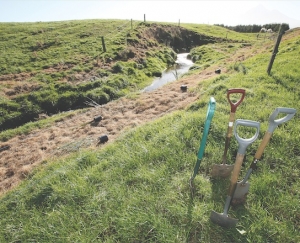So it’s timely to look at the issues involved in erosion and land management practices that can contribute to contamination of waterways.
Some Waikato rivers, lakes and streams have eroding banks, silted beds, water weed infestation and debatable water quality, often the result of sub-optimal land management.
Such practices – whether related to farming, forestry, roading or horticulture – can cause soil erosion and a build-up of contaminants such as bacteria and chemicals which end up being washed into watercourses during heavy rain.
Stock wading in water, poor cowshed effluent treatment, overgrazing, inappropriate fertiliser application, pugging and poor runoff control on cultivated land, roads and tracks can all contribute to the contamination of water bodies. Bacteria can cause water-borne diseases like giardia and cryptosporidium which in turn can cause serious health problems, while nitrates and phosphates can also create severe health disorders for people and stock, and contribute to algal growth.
Good management of the banks of waterways can reduce these effects by stabilising the banks and providing a filter for contaminants washing off the land. Effective management of the banks, ie riparian strips, is a key to protecting aquatic life and improving water quality.
Careful selection of the mix of species planted within riparian areas makes it possible to beneficially modify what’s happening with light, temperature, nutrient and sediment loads, channel and bank stability, carbon inputs, and habitat for terrestrial species.
A well-managed riparian margin will filter out contaminants such as sediments and nutrients from farm run-off, including soil, animal dung and urine and agricultural chemicals.
Shrubs and trees with extensive root systems, which tolerate moist soil and frequent silt deposits, are ideal for stream bank erosion control. They physically hold the stream banks together and some tree roots also protect the streambed, limiting the scouring effect of running water. Streamside vegetation provides shade which cools the water, improves dissolved oxygen levels, helps aquatic life and reduces the risk of algal blooms.
Suitable plant species beside waterways also provide cover for spawning fish, and food and habitat for nesting and juvenile birds. Such planting helps water plants and invertebrates become numerous, providing a better food supply for fish. Streamside trees can link areas of native vegetation, extending habitat for native birds.
Besides environmental benefits, riparian planting can also help a farm’s economics.
Well designed riparian fencing can be used to improve subdivision, help with mustering, and protect animals from drowning or getting stuck in wet areas. The provision of shelter and shade is recognised as an important aspect of animal production and health.
Improved milk grades are documented where dairy sheds no longer draw water from contaminated streams. On sheep and beef properties, stock are in better health and have faster weight gain when water sources are no longer contaminated.
The council’s catchment management officers are available to provide advice on good riparian management.
Tel. 0800 800 401
• Bala Tikkisetty is a sustainable agriculture coordinator at Waikato Regional Council.
















